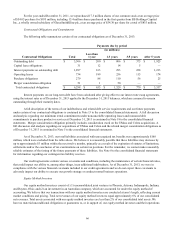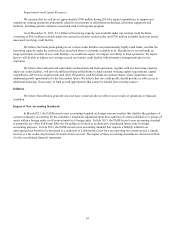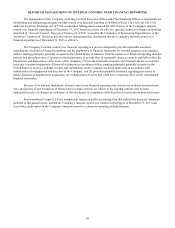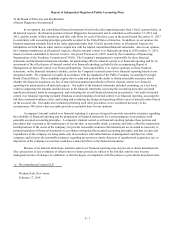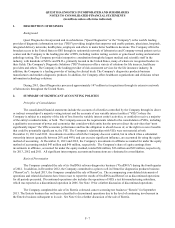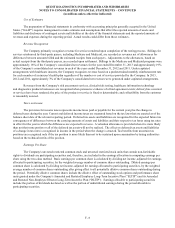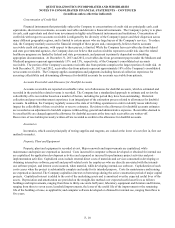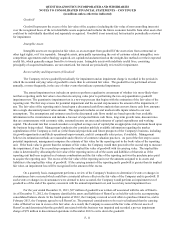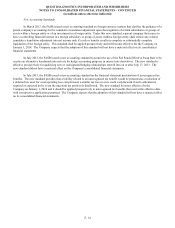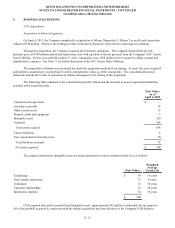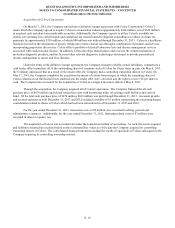Quest Diagnostics 2013 Annual Report Download - page 80
Download and view the complete annual report
Please find page 80 of the 2013 Quest Diagnostics annual report below. You can navigate through the pages in the report by either clicking on the pages listed below, or by using the keyword search tool below to find specific information within the annual report.F- 8
Use of Estimates
The preparation of financial statements in conformity with accounting principles generally accepted in the United
States (“GAAP”) requires management to make estimates and assumptions that affect the reported amounts of assets and
liabilities and disclosure of contingent assets and liabilities at the date of the financial statements and the reported amounts of
revenues and expenses during the reporting period. Actual results could differ from those estimates.
Revenue Recognition
The Company primarily recognizes revenue for services rendered upon completion of the testing process. Billings for
services reimbursed by third-party payers, including Medicare and Medicaid, are recorded as revenues net of allowances for
differences between amounts billed and the estimated receipts from such payers. Adjustments to the allowances, based on
actual receipts from the third-party payers, are recorded upon settlement. Billings to the Medicare and Medicaid programs were
approximately 18% of the Company's consolidated net revenues for the year ended December 31, 2013 and approximately 19%
of the Company's consolidated net revenues in each of the years ended December 31, 2012 and 2011. Under capitated
arrangements with healthcare insurers, the Company recognizes revenue based on a predetermined monthly reimbursement rate
for each member of an insurer's health plan regardless of the number or cost of services provided by the Company. In 2013,
2012 and 2011, approximately 3% of the Company's consolidated net revenues were generated under capitated arrangements.
Revenues from the Company's risk assessment services, clinical trials testing, healthcare information technology
and diagnostics products businesses are recognized when persuasive evidence of a final agreement exists; delivery has occurred
or services have been rendered; the price of the product or service is fixed or determinable; and collectibility from the customer
is reasonably assured.
Taxes on Income
The provision for income taxes represents income taxes paid or payable for the current year plus the change in
deferred taxes during the year. Current and deferred income taxes are measured based on the tax laws that are enacted as of the
balance sheet date of the relevant reporting period. Deferred tax assets and liabilities are recognized for the expected future tax
consequences of differences between the carrying amounts of assets and liabilities and their respective tax bases using tax rates
in effect for the year in which the differences are expected to reverse. A valuation allowance is provided when it is more likely
than not that some portion or all of the deferred tax assets will not be realized. The effect on deferred tax assets and liabilities
of a change in tax rates is recognized in income in the period when the change is enacted. Tax benefits from uncertain tax
positions are recognized only if the tax position is more likely than not to be sustained upon examination by taxing authorities
based on the technical merits of the position.
Earnings Per Share
The Company's unvested restricted common stock and unvested restricted stock units that contain non-forfeitable
rights to dividends are participating securities and, therefore, are included in the earnings allocation in computing earnings per
share using the two-class method. Basic earnings per common share is calculated by dividing net income, adjusted for earnings
allocated to participating securities, by the weighted average number of common shares outstanding. Diluted earnings per
common share is calculated by dividing net income, adjusted for earnings allocated to participating securities, by the weighted
average number of common shares outstanding after giving effect to all potentially dilutive common shares outstanding during
the period. Potentially dilutive common shares include the dilutive effect of outstanding stock options and performance share
units granted under the Company's Amended and Restated Employee Long-Term Incentive Plan (“ELTIP”) and its Amended
and Restated Non-Employee Director Long-Term Incentive Plan (“DLTIP”). Earnings allocable to participating securities
include the portion of dividends declared as well as the portion of undistributed earnings during the period allocable to
participating securities.
QUEST DIAGNOSTICS INCORPORATED AND SUBSIDIARIES
NOTES TO CONSOLIDATED FINANCIAL STATEMENTS – CONTINUED
(in millions unless otherwise indicated)


